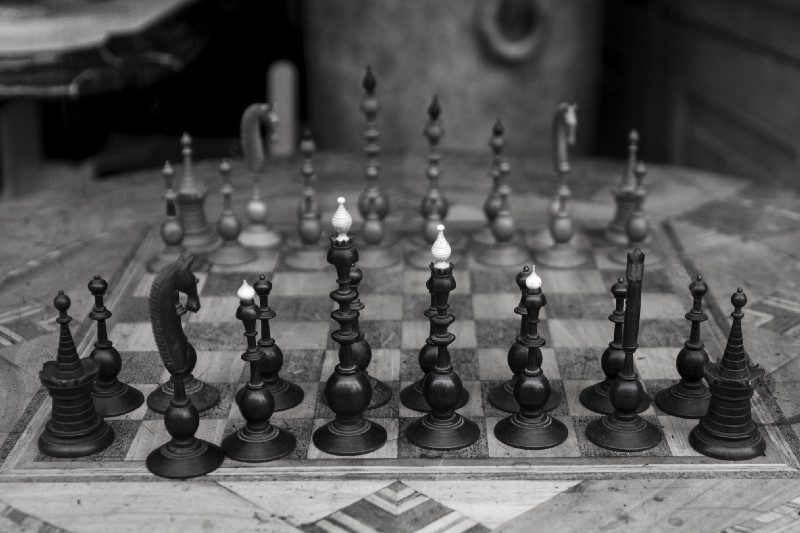The COVID-19 crisis is obviously having a dramatic impact on the world, and its trajectory is at this point unpredictable. As a result, the tremendous uncertainty about what lies ahead can cripple business leaders’ ability to take strategic action. Public policy — regarding financial interventions, for example, and the timing of the reopening of local economies — is often ambiguous and is constantly being revised. When will people feel safe enough to resume normal life? How will this affect their consumption habits? Will social unrest erupt as the economic fallout intensifies? The answers to these questions and more will be of paramount importance to the business environment, but they are largely unknown — rendering forecasts essentially impossible.
Yet paralysis is not an option. In fact, taking action now, during the crisis, will be critical. A previous BCG Henderson Institute analysis showed that companies that began responding and communicating with investors early in the financial crisis of 2008 to 2009, for example, performed significantly better than companies that waited until the full-blown recession hit.
So how can a company become an early actor in a time of extraordinary uncertainty and constant change? One key is to break down the timeline of the crisis into manageable phases — in this case, the current lockdown period, a transition period lasting until the outbreak is brought under control, and the new-normal environment that will follow. Leaders should then build scenarios — and update them frequently by monitoring a variety of real-time indicators — to use as the basis for decision making. A temporary crisis management infrastructure is also necessary. Finally, by applying the military’s OODA (observe-orient-decide-act) loop, the company will be able to act continuously in response to changes in the business environment — and accelerate learning to gain a competitive advantage. Adopting such a military approach to crisis management can help because this is, after all, a matter of survival.
Designing Scenarios and Keeping them Up to Date
The first thing to remember when developing scenarios in such an unpredictable context is not to get lost in unnecessary details and to avoid the lure of false precision. Scenarios should be combinations of assumptions about each of the following factors, which will determine the evolution of the current crisis.
- The Public Health Situation. Estimate the duration, severity, and geographical spread of the outbreak using metrics such as daily reports of active cases, number of patients in intensive-care units, and estimated timelines for the availability of treatment.
- Direct Impact of Government Measures. Track government actions in response to the crisis, which vary by the country and region, and even by the province or state, in which the company operates. Indicators can include lockdown measures, restrictions on sales of “nonessential” items, and mandated closures of stores, offices, hotels, factories, and other assets.
- Macroeconomic Environment. Gauge the intensity and shape of the economic shock generated by the health crisis — such as whether the recovery is expected to be V-shaped, U-shaped, or L-shaped. Indicators can include unemployment levels, investment levels, and insolvency and bankruptcy rates. Central-bank monetary policy responses and government stimulus and financial support for businesses should also be taken into account.
- Business-Specific Demand. This is a more granular view of evolving demand in specific sectors as a result of the outbreak.
To inform the scenarios and keep them up to date, companies should build a “cockpit” — a dynamic indicator dashboard — to view both backward-looking and forward-looking KPIs for each of these factors in real time. (See Exhibit 1.) Backward-looking data that takes into account the precrisis situation will help companies monitor the trajectory of the crisis and understand the underlying factors that could influence it. The evolution of demand, for example, could be modeled as a correlation with declining GDP for a specific sector. Forward-looking early-warning indicators, meanwhile, can help analysts detect weak signals in the changing environment — such as rebounds in demand or new patterns of consumer behavior.
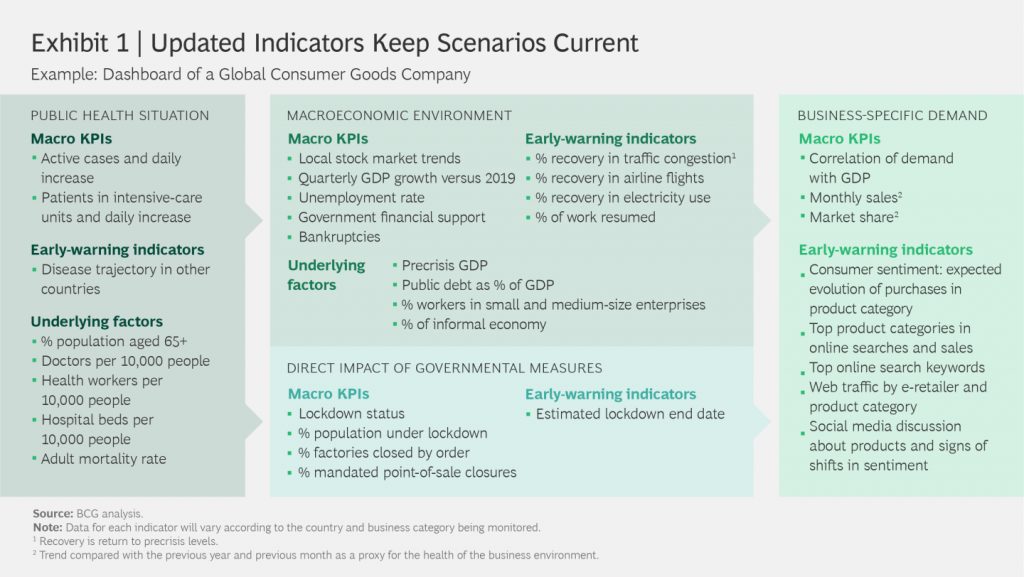
One luxury brand tracked trends in South Korea and China, where the company detected a strong correlation between online searches and increasing sales a few days later. As a result, the company was able to develop credible scenarios for its other important markets. This example highlights the importance of using sophisticated measurement capabilities and larger datasets as they accumulate. And companies able to leverage AI analytics can gain an immediate advantage.
While excellent data can promote informed decision making, it won’t provide certainty about how the health crisis and its aftermath will actually play out. At some point, a company’s leaders need to take a leap of faith and decide what they think the future will look like — and then act decisively. For example, they will have to make an educated guess about whether lockdowns will last two months or four, and whether or not a vaccine will be available in 2021.
Leaders must forge a strong consensus on a “reference scenario” for each of their business categories and for each region or country in which the company operates. Thus, the reference scenario for South Korea, which is not crippled by lockdowns, would be different from the reference scenario for a market that is in lockdown. Similarly, in countries where restaurants and cafes are shut down, food retailers can anticipate strong demand in retail stores — and even stronger demand for online sales. In other sectors, meanwhile, scenarios for brick-and-mortar retailers may include a massive decline in demand due to government restrictions and call for a radically different response. Once the reference scenarios are set, leadership will need to unite the company and set a clear strategic direction — just as a military command center would do in wartime.
Importantly, the reference scenarios must be continuously adjusted in response to changes in the environment detected through the indicators in the cockpit. The scenario development process needs to be dynamic, with indicators tracked in real time and advanced analytics leveraged to constantly increase accuracy and the rate of learning. Again, companies able to use AI-powered analytics will have an edge.
Using Scenarios to Drive the Strategic Response
We recommend four guidelines to maximize the impact of the reference scenarios on strategic decision making.
Build strategies based on the company’s starting point and reference scenarios. Companies entered the COVID-19 crisis with different market shares, cash reserves, levels of digitization, and other characteristics. Leaders must consider these factors when determining their overarching strategic response. For some companies, it may be a time for bold moves, such as aggressively pursuing M&A. Others may decide it is better to focus on resilience than on maximizing financial outcomes. During the four previous US downturns since 1986, only 44% of companies experienced shrinking EBIT margins and sales growth. Forty-two percent increased one or the other, and 14% increased both. Of course, the COVID-19 crisis is different in many ways from those downturns. Nevertheless, companies that remain lucid and bold are the most likely to emerge as outperformers.
Consider different time horizons. Thus far, companies have mainly focused on mitigating short-term losses and adjusting ways of working to protect their employees. This is necessary but not enough, because the COVID-19 crisis will have long-lasting impacts. We believe companies need to plan for three time horizons. (See Exhibit 2.)
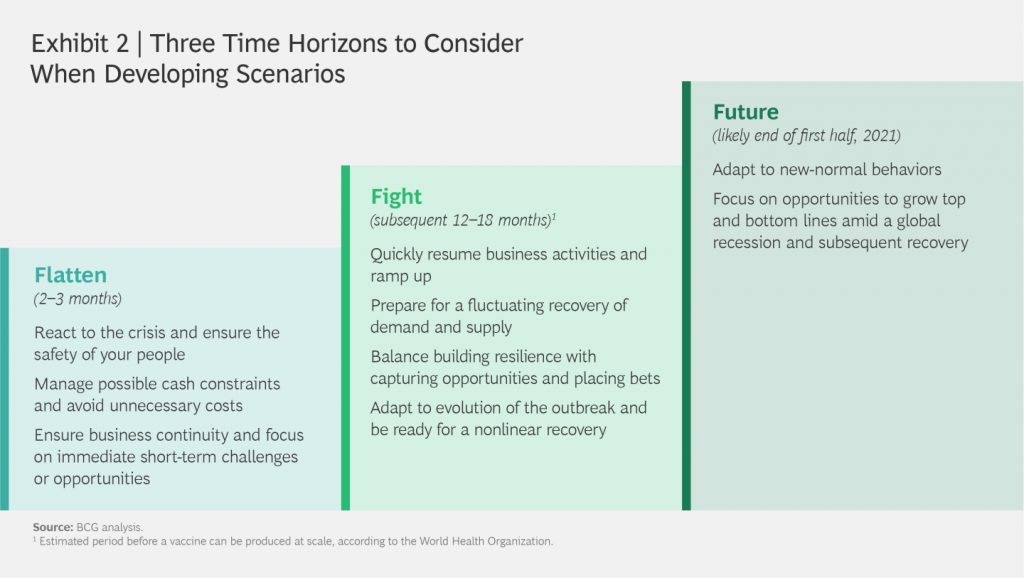
- Flatten (two to three months). Given the precedent of China’s Hubei province, where the COVID-19 outbreak originated, it will take at least two to three months for a government-ordered lockdown to control the outbreak. During this time, leaders should focus on protecting the health of their workforce, managing cash constraints and avoiding unnecessary costs, ensuring business continuity, and other immediate challenges or opportunities.
- Fight (the subsequent 12 to 18 months). Although the outbreak may by now have peaked, it is likely to be more than a year before a vaccine or an effective treatment can be produced at scale, according to World Health Organization estimates. Companies can resume business activities during this period and prepare for a fluctuating recovery from demand and supply shocks. This transition phase is a time to find the right balance between building resilience and capturing opportunities. During this crucial period, leaders should focus on ensuring that their companies outperform and building the foundation for longer-term competitive advantage.
- Future (likely around the end of first half, 2021). After the public health crisis abates, companies must adapt to new customer behaviors and focus on opportunities to grow the top and bottom lines during a likely global economic recession and subsequent recovery.
Use the OODA loop to continuously adapt action plans. During the crisis, businesses should apply the military’s OODA loop as a guiding principle. Observe in order to adjust the reference scenario based on the cockpit indicators; orient by identifying the strategic options according to the company’s starting point; decide on the most effective option; and act quickly and accordingly. (See Exhibit 3.) Running this loop frequently increases the rate of learning, which is fundamental to preparing for rapid change and quickly taking corrective action.
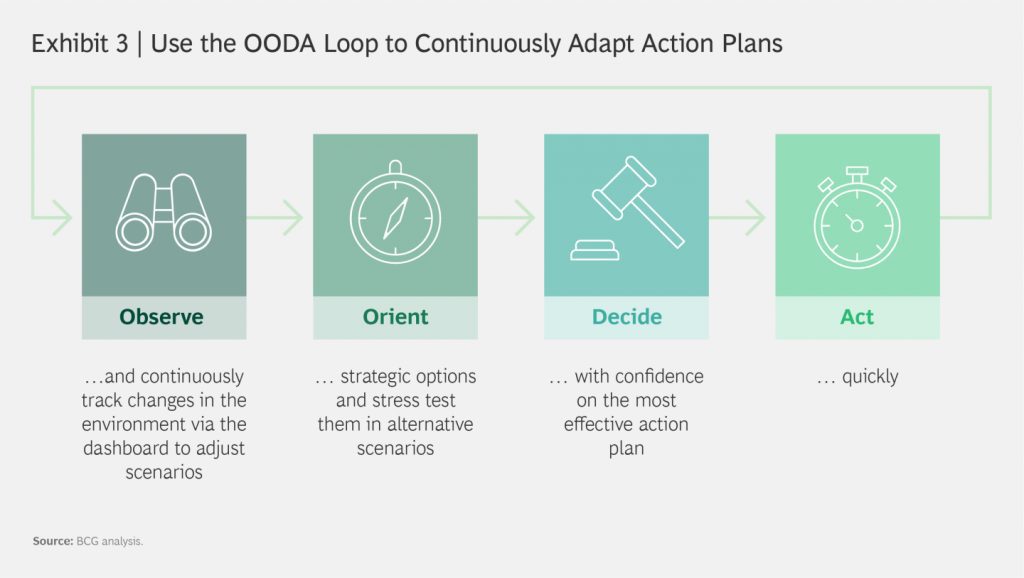
During the observation phase, accurate cockpit indicators and leaders who are open to revisiting the reference scenarios are essential to the company’s ability to adjust rapidly as needed. And the orientation phase is especially crucial. To arrive at the best outcomes, companies must be aware of weak spots in their plans ahead of time. Strategic responses should be stressed tested under multiple scenarios, including extreme ones.
Consider a scenario in which the lockdown period lasts twice the expected length, for example, and see what breaks down first in the action plan. To speed up decision making in the decide and act phases of the loop, the military’s central command defines the overall strategy, while officers and soldiers are empowered to make tactical decisions based on real-time information on the ground. Similarly for businesses, there should be central strategic decision making, with local teams retaining the ability to adjust and implement tactical moves.
Increase the chance of success by proactively shaping the business environment. Just as armies shape their surroundings to their advantage, companies can work to shape the policy environment to their advantage, as long as this does not jeopardize employee or customer safety — because trust is critical to the recovery. During the lockdown period, for example, a retailer can lobby for its products to be considered essential items authorized for sale. And during the transition period, companies can pilot new safety measures and work with regulators to lift restrictions if their workers’ health is not at risk.
A company repurposing production capacity to make protective gear such as masks and scrubs, for example, can both meet a public need and get an early start refining production methods that may be needed in the fight phase — such as assembly lines that ensure adequate social distancing. Companies can also lead the dialogue with governments to design the contours of the new normal.
Building the Supporting Organizational Structure
Strategy must be intertwined with execution. This scenario-based approach therefore requires an adequate organizational structure to deliver impact. We recommend that companies set up two temporary crisis offices that report to the executive committee, each with different priorities. (See Exhibit 4.)
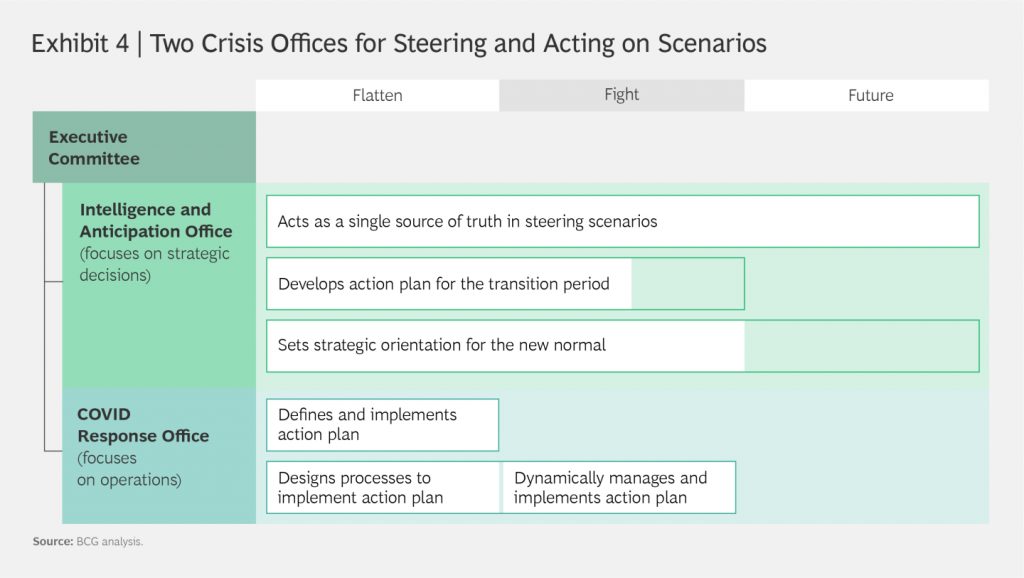
The first unit (call it the intelligence and anticipation office, or IAO) focuses on strategic decision making across all time horizons; it receives primary attention from the CEO and executive committee and acts as the single source of truth for adapting scenarios across the organization. The IAO owns the dynamic indicator cockpit and serves as the company’s repository of quantitative and qualitative data for COVID-19-related analysis. The IAO is also in charge of developing an action plan for the transition phase that could involve reassessing portfolio priorities, reactivating workforces, ramping up supply chains, and reorienting strategy in response to structural changes in the business environment or opportunities that arise in the new normal.
The second unit, the COVID response office (CRO), is in charge of operations during the Flatten and Fight phases. It has the authority to define immediate actions along three dimensions:
- Workforce Management. People management is critical during crises. The CRO develops health guidelines, proposes working arrangements, and designs engagement programs. It needs to ensure employees’ respect for the legitimacy of the ongoing “fight” and maintain cohesion in the workforce, especially when some are taking risks on the ground while others work remotely.
- Operational Continuity. The CRO has responsibility for prioritizing and protecting operations that are vital to the business. It might categorize operations on the basis of their criticality, for example, and design and implement contingency plans for those with the highest priority.
- Stakeholder Engagement. The CRO must reassure key stakeholders, such as core customers, suppliers, and investors, that the company is taking the right measures and, when appropriate, cooperate with them to develop emergency contingency plans. Before the company develops a response and mobilizes its sales force, for example, the CRO should systematically reach out to key customer accounts to discuss their needs.
In addition, the CRO is responsible for implementing the action plans defined by the IAO for the Fight phase, and it has ultimate authority for any changes in response to sudden and unexpected developments. It should also be in continuous alignment with a potential cash management office that manages liquidity.
As inspiration, both the IAO and the CRO can draw on military crisis management principles. They should provide the equivalent of wartime operational briefings on a daily basis to update leadership. Top management should also apply this military leadership maxim: absorb worry, diffuse confidence, and win trust through transparency. The company’s leaders should think carefully when selecting people to head up these offices and consider candidates — whether from inside or outside the company — with experience fighting previous public health crises, such as the SARS or the MERS outbreaks.
The unprecedented complexity and uncertainty generated by the COVID-19 crisis should not prevent business leaders from acting. We strongly believe that this scenario-based approach will be key to success. It will enable companies to continuously observe changes in the environment in order to adjust scenarios, to orient their strategic options, to confidently decide upon an action plan, and to act on that plan quickly. Repeating this loop frequently will reinforce learning and increase the number of potential responses and their effectiveness.
When combined with a good crisis management organizational structure, the scenario approach will allow companies to remain lucid and make bold, effective, and impactful moves. But it should not prevent leaders from preparing for the future, because after the dust settles, companies will confront a new normal. Therefore, they must continue with their long-term strategic thinking. As French Prime Minister Clemenceau said after the conclusion of World War I, “We have won the war, and not without pain, but now we must win the peace, and that will perhaps be more difficult.”



